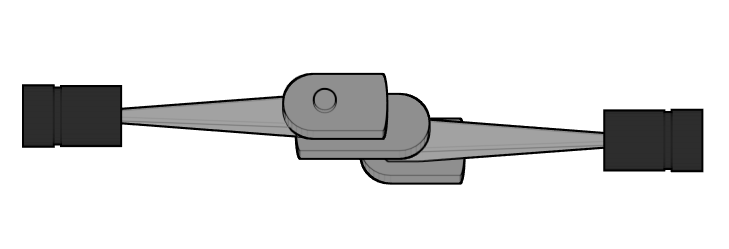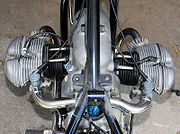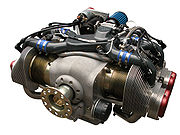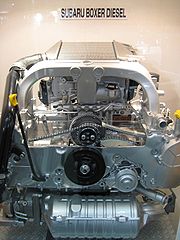
Flat engine
Encyclopedia

Internal combustion engine
The internal combustion engine is an engine in which the combustion of a fuel occurs with an oxidizer in a combustion chamber. In an internal combustion engine, the expansion of the high-temperature and high -pressure gases produced by combustion apply direct force to some component of the engine...
with multiple pistons that move in a horizontal plane. Typically, the layout has cylinder
Cylinder (engine)
A cylinder is the central working part of a reciprocating engine or pump, the space in which a piston travels. Multiple cylinders are commonly arranged side by side in a bank, or engine block, which is typically cast from aluminum or cast iron before receiving precision machine work...
s arranged in two banks on either side of a single crankshaft
Crankshaft
The crankshaft, sometimes casually abbreviated to crank, is the part of an engine which translates reciprocating linear piston motion into rotation...
and is sometimes known as the boxer, or horizontally opposed engine. The concept was patent
Patent
A patent is a form of intellectual property. It consists of a set of exclusive rights granted by a sovereign state to an inventor or their assignee for a limited period of time in exchange for the public disclosure of an invention....
ed in 1896 by engineer Karl Benz
Karl Benz
Karl Friedrich Benz, was a German engine designer and car engineer, generally regarded as the inventor of the gasoline-powered car, and together with Bertha Benz pioneering founder of the automobile manufacturer Mercedes-Benz...
. It should not to be confused with the opposed-piston engine, in which each cylinder has a piston at both ends and no cylinder head.
Another widely used form of flat engine consists of a straight engine
Straight engine
Usually found in four- and six-cylinder configurations, the straight engine, or inline engine is an internal-combustion engine with all cylinders aligned in one row, with no offset...
with two, three, four or more cylinders canted 90 degrees into the horizontal plane, however this is not generally considered significantly different from other straight engines.
Configuration



Center of mass
In physics, the center of mass or barycenter of a system is the average location of all of its mass. In the case of a rigid body, the position of the center of mass is fixed in relation to the body...
and thereby may offer a drive configuration with better stability and control. Flat engines lend themselves well to aircraft engine
Aircraft engine
An aircraft engine is the component of the propulsion system for an aircraft that generates mechanical power. Aircraft engines are almost always either lightweight piston engines or gas turbines...
s.
Front-mounted air-cooled flat-twin engines were used in Tatra 11
Tatra 11
The Tatra T11 was the first Tatra model to use the unique combination of major components that are still in use on the trucks produced by Tatra to this day.-Origins:...
and Tatra 30
Tatra 30
Tatra 30 is a model of vintage automobile made by Czech manufacturer Tatra.It was manufactured between 1926 and 1928. From 1928 to 1931 the car was fitted with newer engine and is therefore caller Tatra 30/52.-Tatra 30:...
, by Citroën
Citroën
Citroën is a major French automobile manufacturer, part of the PSA Peugeot Citroën group.Founded in 1919 by French industrialist André-Gustave Citroën , Citroën was the first mass-production car company outside the USA and pioneered the modern concept of creating a sales and services network that...
in their model 2CV
Citroën 2CV
The Citroën 2CV |tax horsepower]]”) was an economy car produced by the French automaker Citroën between 1948 and 1990. It was technologically advanced and innovative, but with uncompromisingly utilitarian unconventional looks, and deceptively simple Bauhaus inspired bodywork, that belied the sheer...
and its derivatives, while the GS and GSA
Citroën GS
The Citroën GS and Citroën GSA are small family cars produced by the French automaker Citroën. The GS was voted European Car of the Year for 1971, and was probably the most technologically advanced car in its class when launched, with class leading comfort, safety and aerodynamics.-Market...
. Oltcit
Oltcit
The Oltcit was a Romanian car developed in co-operation with Citroën of France in the 1980s. It is a small three-door hatchback, based on the Citroën Prototype Y and built in Craiova at the Automobile Craiova plant.-History:...
used a flat-four and a flat-six was proposed for the Citroën DS
Citroën DS
The Citroën DS is an executive car produced by the French manufacturer Citroën between 1955 and 1975. Styled by Italian sculptor and industrial designer Flaminio Bertoni and the French aeronautical engineer André Lefèbvre, the DS was known for its aerodynamic futuristic body design and innovative...
but rejected. BMW
BMW Motorrad
BMW Motorrad is the motorcycle brand of the German company BMW, part of its Corporate and Brand Development division. The current General Director of the unit is Hendrik von Kuenheim....
has used air- or air/oil-cooled flat-twin engines in its motorcycles from 1923 until the present day. Cars such as the Porsche 911
Porsche 911
The Porsche 911 is a luxury 2-door sports coupe made by Porsche AG of Stuttgart, Germany. It has a distinctive design, rear-engined and with independent rear suspension, an evolution of the swing axle on the Porsche 356. The engine was also air-cooled until the introduction of the Type 996 in 1998...
use a flat-engine (in that particular case a six-cylinder) at the rear of the car, where its extra width does not interfere with the steering of the front wheels and there is a weight-saving since no prop-shaft is required.
All versions of the Subaru Impreza
Subaru Impreza
Introduced in November 1993, the Impreza was offered in either front-wheel drive or all-wheel drive versions and as a four-door sedan/saloon or five-door station wagon/estate. According to a Motor Trend article written March 1992 on page 26, the name of Subaru's new compact was, initially, to be...
, Forester
Subaru Forester
The Subaru Forester is an all-wheel drive crossover wagon manufactured since 1997 by Fuji Heavy Industries and sold under the Subaru brand...
, Tribeca
Subaru Tribeca
The Subaru Tribeca is a mid-size crossover SUV sold since 2005 by Subaru, the automobile manufacturing division of Japanese transportation conglomerate Fuji Heavy Industries . Released in some markets as the Subaru B9 Tribeca, the name "Tribeca" derives from the TriBeCa neighborhood of New York City...
, Legacy
Subaru Legacy
The Subaru Legacy is a mid-size car built by the Japanese company Fuji Heavy Industries, and manufactured by its division Subaru since 1989, and is available as a sedan or wagon. Part of the original design goals for the Legacy model was to provide Subaru a vehicle in which they could compete in...
, Outback
Subaru Outback
The Subaru Outback is a station wagon manufactured by Fuji Heavy Industries since 1995. Its original concept originated with Subaru of America, which was suffering from slumping sales in the mid-1990s partly due to a lack of an entry in the then-burgeoning sport utility vehicle market...
, Baja
Subaru Baja
The Subaru Baja is a light-utility, all-wheel-drive, four passenger, four-door, open-bed vehicle manufactured from 2003-2006 by Subaru. The Baja combines the handling and passenger carrying characteristics of a car with the open-bed versatility, and to a lesser degree, load capacity of a pickup...
and SVX
Subaru Alcyone SVX
The Subaru Alcyone SVX, also known outside of its home market Japan as the Subaru SVX, is a two-door grand tourer coupé that was sold by Subaru, the automobile manufacturing division of Japanese transportation conglomerate Fuji Heavy Industries . Produced from 1991 to 1997, it was FHI's first...
use either a flat-4 or flat-6 engine.
True boxers have each crankpin controlling only one piston/cylinder while 180° engines, which superficially appear very similar, share crankpins.
- The boxer engine has corresponding pistons reaching top dead centreDead centreIn a reciprocating engine, the dead centre is the position of a piston in which it is farthest from, or nearest to, the crankshaft. The former is known as top dead centre while the latter is known as bottom dead centre ....
(TDC) simultaneously.
- The 180° V engineV engineA V engine, or Vee engine is a common configuration for an internal combustion engine. The cylinders and pistons are aligned, in two separate planes or 'banks', so that they appear to be in a "V" when viewed along the axis of the crankshaft...
has corresponding pistons sharing a crankpin on the crankshaft and reaching TDC half a crankshaft revolution apart. They may use regular connecting rodConnecting rodIn a reciprocating piston engine, the connecting rod or conrod connects the piston to the crank or crankshaft. Together with the crank, they form a simple mechanism that converts linear motion into rotating motion....
s side by side, or use a master/slave system, or a fork-and-blade system. Flat engines with more than eight cylinders are most commonly V engines.
Boxer engines must not be confused with opposed-piston engines, which are essentially the inverse, with two pistons compressing a single combustion space. These can be used in vehicles such as tanks.
Boxer engines
Boxer engines got their name because each pair of pistons moves simultaneously in and out rather than alternately, like boxers showing they are ready by clashing their gloved fists against each other before a fight. Boxer engines of up to eight cylinders have proved highly successful in automobileAutomobile
An automobile, autocar, motor car or car is a wheeled motor vehicle used for transporting passengers, which also carries its own engine or motor...
s and up to six cylinders in motorcycles and continue to be popular for light aircraft
Light aircraft
A light aircraft is an aircraft that has a maximum gross take-off weight of or less.Many aircraft used commercially for freight, sightseeing, photography and scheduled flights are light aircraft.Examples of light aircraft include:...
engines.
Boxers are one of only three cylinder layouts that have a natural dynamic balance; the others being the straight-6
Straight-6
The straight-six engine or inline-six engine is a six-cylinder internal combustion engine with all six cylinders mounted in a straight line along the crankcase...
and the V12
V12 engine
A V12 engine is a V engine with 12 cylinders mounted on the crankcase in two banks of six cylinders, usually but not always at a 60° angle to each other, with all 12 pistons driving a common crankshaft....
. These engines can run very smoothly and free of unbalanced forces with a four-stroke cycle and do not require a balance shaft
Balance shaft
In piston engine engineering, a balance shaft is an eccentric weighted shaft which offsets vibrations in engine designs that are not inherently balanced...
or counterweights on the crankshaft
Crankshaft
The crankshaft, sometimes casually abbreviated to crank, is the part of an engine which translates reciprocating linear piston motion into rotation...
to balance the weight of the reciprocating parts, which are required in other engine configurations. Note that this is generally true of boxer engines regardless of the number of cylinders (assumed to be even), but not true for all V or inline engines. However, in the case of boxer engines with fewer than six cylinders, unbalanced moments (a reciprocating torque also known as a "rocking couple") are unavoidable due to the "opposite" cylinders being slightly out of line with each other.
Boxer engines (and flat engines in general) tend to be noisier than other common engines for both intrinsic and other reasons, e.g., in cars, valve clatter from under the hood is not damped by large air filters and other components. Boxers need no balance weights on the crankshaft, which is lighter and fast-accelerating. They have a characteristic smoothness throughout the rev range and offer a low centre of gravity.
Notable flat engines

- In 1896, Karl BenzKarl BenzKarl Friedrich Benz, was a German engine designer and car engineer, generally regarded as the inventor of the gasoline-powered car, and together with Bertha Benz pioneering founder of the automobile manufacturer Mercedes-Benz...
invented the first internal combustion engineInternal combustion engineThe internal combustion engine is an engine in which the combustion of a fuel occurs with an oxidizer in a combustion chamber. In an internal combustion engine, the expansion of the high-temperature and high -pressure gases produced by combustion apply direct force to some component of the engine...
with horizontally opposed pistons. - In 1923 Max Friz designed the first BMW motorcyclesBMW motorcyclesBMW's motorcycle history began in 1921 when the company commenced manufacturing engines for other companies. Motorcycle manufacturing now operates under the BMW Motorrad brand...
, choosing a 500 cc boxer engine and unit transmission with shaft drive. This engine type is still in production today. The BMW 247 engine, known as an airheadAirhead (motorcycle)Airheads are the traditional BMW motorcycles with a flat-twin air-cooled engine that were built from 1923 to 1995...
due to its air cooling, was produced until 1995. BMW replaced it with the oilheadOilheadAn oilhead is the name used for BMW motorcycle engines that advertise the use of oil cooling to transfer some of the heat from the engine to the atmosphere....
engine with partial oil cooling and four valves per cylinder, but still retaining the same flat-twin configuration. - In 1948 Preston TuckerPreston TuckerPreston Thomas Tucker was an American automobile designer and entrepreneur.He is most remembered for his 1948 Tucker Sedan , an automobile which introduced many features that have since become widely used in modern cars...
modified a helicopter flat-six to be rear-mounted in his Tucker Torpedo1948 Tucker SedanThe 1948 Tucker Sedan or Tucker '48 Sedan was an advanced automobile conceived by Preston Tucker and briefly produced in Chicago in 1948... - The Volkswagen air-cooled flat-four engine used in the Volkswagen BeetleVolkswagen BeetleThe Volkswagen Type 1, widely known as the Volkswagen Beetle or Volkswagen Bug, is an economy car produced by the German auto maker Volkswagen from 1938 until 2003...
, SP2Volkswagen SP2The SP2 was a sports car developed by Volkswagen do Brasil for that market, from 1972 to 1976; the name is an abbreviation of "São Paulo".-Origins of the project:...
and Karmann Ghia, and later developed further for the Volkswagen Type 2Volkswagen Type 2The Volkswagen Type 2, officially known as the Transporter or Kombi informally as Bus or Camper , was a panel van introduced in 1950 by German automaker Volkswagen as its second car model – following and initially deriving from Volkswagen's first model, the Type 1 , it was given the factory...
(Bus) transporters and Volkswagen Type 3Volkswagen Type 3The Volkswagen Type 3 was a range of small cars from German manufacturer Volkswagen , introduced at the 1961 Frankfurt Motor Show, Internationale Automobil-Ausstellung ....
cars. VW was rumoured to have worked on a Diesel version of the aircooled boxer but abandoned this engine due to noise and heat issues. The latest version of the VW boxer was watercooled and thus dubbed the 'Wasserboxer' or waterboxer by enthusiasts. This engine included many developments of the earlier engines. It was offered in capacities of 1.9 and 2.1 litres was used to power T3 buses and transporters. - The Citroën 2CVCitroën 2CVThe Citroën 2CV |tax horsepower]]”) was an economy car produced by the French automaker Citroën between 1948 and 1990. It was technologically advanced and innovative, but with uncompromisingly utilitarian unconventional looks, and deceptively simple Bauhaus inspired bodywork, that belied the sheer...
and Panhard air-cooled flat-twin engines, both influenced by the flat-twins of BMW - The air-cooled Chevrolet CorvairChevrolet Corvair-First generation :The 1960 Corvair 500 and 700 series four-door sedans were conceived as economy cars offering few amenities in order to keep the price competitive, with the 500 selling for under $2,000...
OHV flat-six - In 1960 Lancia's flat-four water-cooled engine debuted for the Lancia FlaviaLancia FlaviaThe Lancia Flavia is a medium sized luxury saloon, launched with a 1500 cc engine at the 1960 Turin Motor Show by Lancia and introduced in major European markets during the next twelve months. Coupe and cabriolet versions developed by Pininfarina quickly followed, together with one or two low...
model, first Italian front-wheel drive car, like 1500 cc 90 PS coupé version and during the years become a 2000 cc with 142 bhp when was mounted the first electronic Injection by Bosch in 1970 in a flat four engine, Lancia also rebuild a new big flat-four engine in 1976, 2484 cc, for his upper size model Lancia GammaLancia GammaThe Lancia Gamma is an executive car from Italian Fiat Auto's up-scale Lancia marque. Presented in 1976 at the Geneva Motor Show as Lancia's new flagship, it filled the void in Lancia's lineup left by the demise of the Flavia...
. It was produced until 1984 and was Lancia's last flat-four engine. - The flat-four engines in Alfa Romeo's Alfasud, SprintAlfa Romeo SprintThe Alfa Romeo Sprint is a coupé version of the Alfa Romeo Alfasud, produced from 1976 to 1989 by Alfa Romeo. 116,552 examples of the Alfasud Sprint and Alfa Romeo Sprint were built in total. The Sprint was sold in Europe, South Africa, Australia and New Zealand.-History:Until 1983, the car's name...
, 33 and early versions of the 145Alfa Romeo 145The Alfa Romeo 145 and 146 are small family cars produced by the Italian automaker Alfa Romeo between 1994 and 2001. They were launched at the 1994 Turin Motor Show...
. The last of the line was a 1,712 cc flat-four, 16-valves, producing up to 137 PS. - The Toyota Sports 800Toyota Sports 800The Toyota Sports 800 was Toyota Motor Corporation's first production sports car. The prototype for the Sports 800, called the Toyota Publica Sports, debuted at the 1962 Tokyo Auto Show, featuring a space age sliding canopy and utilizing the power train of the Toyota Publica 700, a Japanese market...
was Toyota's first sports car, and contained a two-cylinder Boxer engine, the 2UToyota U engineThe Toyota U family was a series of flat-twin engines produced in the 1960s and 1970s.-2U:The 0.8 L 2U was produced from 1965 through 1969, while the similar 2U-B was produced from 1966 through 1976. Output for the B was 49 hp at 5400 RPM.-External links:*...
. - The water-cooled front-mounted flat-four and flat-six engines used by SubaruSubaru; is the automobile manufacturing division of Japanese transportation conglomerate Fuji Heavy Industries .Subaru is internationally known for their use of the boxer engine layout popularized in cars by the Volkswagen Beetle and Porsche 911, in most of their vehicles above 1500 cc as well as...
in all of its mid-sized cars. Subaru refers to these as boxer engines in publicity commentary, and include a variety of naturally aspirated and turbo driven engines from 1966, when the Subaru 1000Subaru 1000The ' was a compact car and introduced in Japan July 10, 1970, replacing the FF-1 Star. It was a front wheel drive vehicle with a typical Subaru EA61 or EA62 flat-4 engine. A fully independent torsion bar suspension and rack and pinion steering were impressive for the time. The inboard front...
was introduced to current; both closed and semi-closed short blocks have been used. A print add for the 1973 Subaru GL coupe referred to the engine as "quadrozontal" The EJ series of four-cylinder engines released first in 1990 has been the focus for the development of the Boxer engine in the late 20th century. Ranging from 1.6–2.5 litres, this engine in its 2-litre turbo arrangement has been the power behind World Rally Championship winning cars. Subaru also offers a boxer turbodiesel, called the Subaru EE series, the world's first to be fitted into a passenger car. - Since its introduction in 1975, the Honda GoldwingHonda GoldwingThe Honda Gold Wing is a touring motorcycle designed and manufactured by Honda. It was introduced October 1974, and went on to become a popular model in North America, Western Europe and Australia. Over the course of its history, it has had numerous modifications to its design. In 1975 it featured...
has utilized a boxer engine, a four-cylinder until 1987, and six-cylinders since. The water-cooled SOHC 1,832 cc flat-six is fitted to the Honda GoldwingHonda GoldwingThe Honda Gold Wing is a touring motorcycle designed and manufactured by Honda. It was introduced October 1974, and went on to become a popular model in North America, Western Europe and Australia. Over the course of its history, it has had numerous modifications to its design. In 1975 it featured...
from 2001 on. - The air-cooled flat-four, flat-six and flat-eight engines were used for many years in early Porsches. The flat-twelve in the 917Porsche 917The Porsche 917 is a racecar that gave Porsche its first overall wins at the 24 Hours of Le Mans in 1970 and 1971. Powered by the Type 912 flat-12 engine of 4.5, 4.9, or 5 litres, the 917/30 variant was capable of a 0- time of 2.3 seconds, 0– in 5.3 seconds, and a top speed of over .There are 6...
model is a 180° V-engine and not a boxer. - The water-cooled flat-six engines in the Porsche BoxsterPorsche BoxsterThe Porsche Boxster is a mid-engined roadster built by Porsche. The Boxster is Porsche's first road vehicle to be originally designed as a roadster since the 550 Spyder....
, CaymanPorsche CaymanThe Porsche Cayman is a mid-engined, rear wheel drive 2-seat sports car produced by Porsche AG of Germany. First launched in the 2006 model year, the Cayman is a coupé derived from Porsche's second generation Boxster convertible. Like the Boxster, most Caymans were assembled in Finland for Porsche...
and later 911Porsche 911The Porsche 911 is a luxury 2-door sports coupe made by Porsche AG of Stuttgart, Germany. It has a distinctive design, rear-engined and with independent rear suspension, an evolution of the swing axle on the Porsche 356. The engine was also air-cooled until the introduction of the Type 996 in 1998...
models - General aviationGeneral aviationGeneral aviation is one of the two categories of civil aviation. It refers to all flights other than military and scheduled airline and regular cargo flights, both private and commercial. General aviation flights range from gliders and powered parachutes to large, non-scheduled cargo jet flights...
aircraft often use air-cooled flat-four and flat-six engines made by companies such as LycomingLycoming EnginesLycoming Engines is a U.S. aircraft engine company, known primarily for its general aviation engines. For most of its history Lycoming has been part of the AVCO group as AVCO Lycoming. In 1987 AVCO was purchased by Textron to become Textron Lycoming...
, Continental. Ultralight and microlightUltralight aviationThe term "ultralight aviation" refers to light-weight, 1- or 2-person airplanes., also called microlight aircraft in the UK, India and New Zealand...
aircraft often use engines such as the Rotax 912 or Jabiru 2200Jabiru 2200| -See also:-External links:* *...
. - FerrariFerrariFerrari S.p.A. is an Italian sports car manufacturer based in Maranello, Italy. Founded by Enzo Ferrari in 1929, as Scuderia Ferrari, the company sponsored drivers and manufactured race cars before moving into production of street-legal vehicles as Ferrari S.p.A. in 1947...
made use of a flat-twelve design in several models, including the Berlinetta Boxer, the Testarossa and its derivatives, such as the 512TR and the F512 M, although this engine design is technically a V12 that has been flattened down to a 180° configuration, and therefore cannot be regarded as a true boxer engine.
Flat engine designs
- Flat-twin engine
- Flat-four engine
- Flat-six engine
- Flat-eight engine
- Flat-ten engine
- Flat-twelve engine
- Flat-sixteen engine
- H engineH engineAn H engine is an engine configuration in which the cylinders are aligned so that if viewed from the front, they appear to be in a vertical or horizontal letter H....
- Controlled Combustion EngineControlled Combustion EngineControlled Combustion Engine is a term used by Revetec, an engine design company, to identify a type of experimental internal combustion engine designed by Brad Howell-Smith. It uses two counter-rotating cams instead of a crankshaft...

